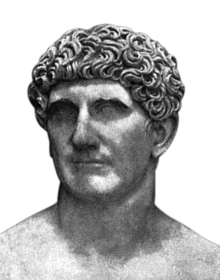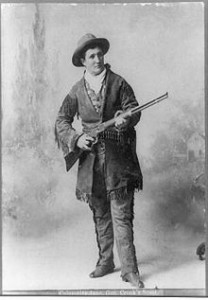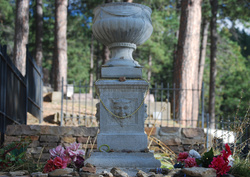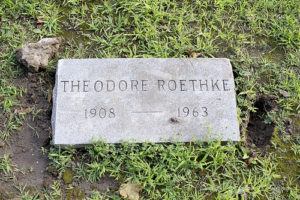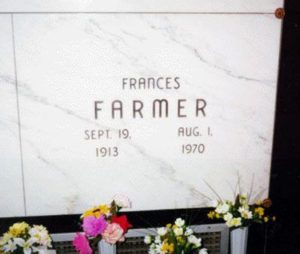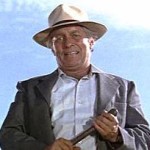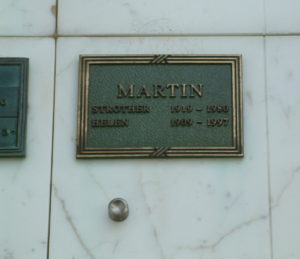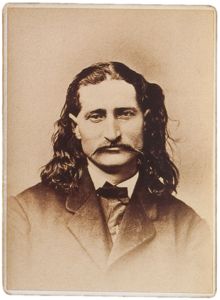 On this day in 1876, gambler, gunfighter, scout and lawman Wild Bill Hickok died, after being shot in the head by John “Broken Nose Jack” McCall at Nuttal & Mann’s Saloon No. 10 in Deadwood, South Dakota, at the age of 39. Born James Butler Hickok on 27 May 1837 in Troy Grove, Illinois. It is difficult to separate the truth from the fiction about Hickok. His exploits, whether real or exaggerated or fabricated, were reported in popular dime novels of the era. He apparently met and associated with several famous or infamous characters including Buffalo Bill Cody, Lieutenant Colonel George Armstrong Custer, John Wesley Hardin and Calamity Jane. Hickok married Agnes Thatcher Lake (1876-1876 his death).
On this day in 1876, gambler, gunfighter, scout and lawman Wild Bill Hickok died, after being shot in the head by John “Broken Nose Jack” McCall at Nuttal & Mann’s Saloon No. 10 in Deadwood, South Dakota, at the age of 39. Born James Butler Hickok on 27 May 1837 in Troy Grove, Illinois. It is difficult to separate the truth from the fiction about Hickok. His exploits, whether real or exaggerated or fabricated, were reported in popular dime novels of the era. He apparently met and associated with several famous or infamous characters including Buffalo Bill Cody, Lieutenant Colonel George Armstrong Custer, John Wesley Hardin and Calamity Jane. Hickok married Agnes Thatcher Lake (1876-1876 his death).
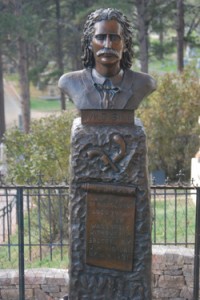 The Final Footprint – Hickok was initially interred in the Ingelside Cemetery, Deadwood’s original graveyard. On the third anniversary of his interment, Hickok’s friend Charlie “Colorado Charlie” Utter paid to move Hickok to the Mount Moriah Cemetery on Mount Moriah. His grave was initially marked by a wooden marker with the inscription; “Wild Bill, J. B. Hickock killed by the assassin Jack McCall in Deadwood, Black Hills, August 2d, 1876. Pard, we will meet again in the happy hunting ground to part no more. Good bye, Colorado Charlie, C. H. Utter.” His grave is now marked by a bronze upright monument with his bust on top. The inscription reads; DIED aug 2 1876 BY PISTOL SHOT AGED 39 years CUSTER WAS LONELY WITHOUT HIM. McCall was tried and aquitted and then tried and convicted for the murder and subsequently hung. Hickok was playing poker at the time of his death and the hand he was holding, a pair of aces and a pair of eights, all black, has become known as “the dead man’s hand”. Hickok has been portayed in numerous books and films. My favorite include; in Thomas Berger’s novels Little Big Man (1964) and The Return of Little Big Man (1999); as played by Gary Cooper in the film The Plainsman (1936) with Jean Arthur as Calamity Jane; as played by Howard Keel in the film Calamity Jane (1953) with Doris Day as Calamity Jane; as played by Charles Bronson in the film The White Buffalo (1977); as played by Sam Elliott in the telvision movie Buffalo Girls (1995) based on the Larry McMurtry novel of the same name with Anjelica Huston as Calamity Jane; as played by Jeff Bridges in the film Wild Bill (1995) with Ellen Barkin as Calamity Jane and John Hurt as Charley Prince, Diane Lane as Susannah Moore, Keith Carradine as Buffalo Bill Cody, David Arquette as Jack McCall, Christina Applegate as Lurline Newcomb, Bruce Dern as Will Plummer.
The Final Footprint – Hickok was initially interred in the Ingelside Cemetery, Deadwood’s original graveyard. On the third anniversary of his interment, Hickok’s friend Charlie “Colorado Charlie” Utter paid to move Hickok to the Mount Moriah Cemetery on Mount Moriah. His grave was initially marked by a wooden marker with the inscription; “Wild Bill, J. B. Hickock killed by the assassin Jack McCall in Deadwood, Black Hills, August 2d, 1876. Pard, we will meet again in the happy hunting ground to part no more. Good bye, Colorado Charlie, C. H. Utter.” His grave is now marked by a bronze upright monument with his bust on top. The inscription reads; DIED aug 2 1876 BY PISTOL SHOT AGED 39 years CUSTER WAS LONELY WITHOUT HIM. McCall was tried and aquitted and then tried and convicted for the murder and subsequently hung. Hickok was playing poker at the time of his death and the hand he was holding, a pair of aces and a pair of eights, all black, has become known as “the dead man’s hand”. Hickok has been portayed in numerous books and films. My favorite include; in Thomas Berger’s novels Little Big Man (1964) and The Return of Little Big Man (1999); as played by Gary Cooper in the film The Plainsman (1936) with Jean Arthur as Calamity Jane; as played by Howard Keel in the film Calamity Jane (1953) with Doris Day as Calamity Jane; as played by Charles Bronson in the film The White Buffalo (1977); as played by Sam Elliott in the telvision movie Buffalo Girls (1995) based on the Larry McMurtry novel of the same name with Anjelica Huston as Calamity Jane; as played by Jeff Bridges in the film Wild Bill (1995) with Ellen Barkin as Calamity Jane and John Hurt as Charley Prince, Diane Lane as Susannah Moore, Keith Carradine as Buffalo Bill Cody, David Arquette as Jack McCall, Christina Applegate as Lurline Newcomb, Bruce Dern as Will Plummer.
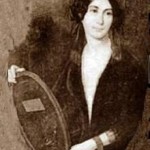 On this day in 1890, French poet Louise-Victorine Ackermann died in Nice at the age of 76. Born Louise-Victorine Choquet on 30 November 1813 in Nice. The work on which Madame Ackermann’s real reputation rests is Poésies, premières poésies, poésies philosophiques (1874) a volume of sombre and powerful verse, expressing her revolt against human suffering.
On this day in 1890, French poet Louise-Victorine Ackermann died in Nice at the age of 76. Born Louise-Victorine Choquet on 30 November 1813 in Nice. The work on which Madame Ackermann’s real reputation rests is Poésies, premières poésies, poésies philosophiques (1874) a volume of sombre and powerful verse, expressing her revolt against human suffering.
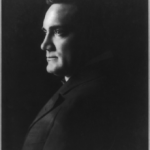 On this day in 1921, Italian tenor Enrico Caruso died at the Vesuvio Hotel in Naples a few minutes after 9:00 am at the age of 48. His death was attributed to peritonitis arising from a burst subrenal abscess. Born in Naples in the Via San Giovannello agli Ottocalli 7 on 25 February 1873. Caruso sang to great acclaim at the major opera houses of Europe and the Americas, appearing in a wide variety of roles from the Italian and French repertoires that ranged from the lyric to the dramatic. Caruso also made approximately 290 commercially released recordings from 1902 to 1920. All of these recordings, which span most of his stage career, are available today on CDs and as digital downloads. Caruso’s 1904 recording of “Vesti la giubba” from Leoncavallo’s opera Pagliacci was the first sound recording to sell a million copies. Prior to World War One, Caruso had been romantically tied to an Italian soprano, Ada Giachetti, who was a few years older than he was. Though already married, Giachetti bore Caruso four sons during their liaison, which lasted from 1897 to 1908. Ada had left her husband, manufacturer Gino Botti, and an existing son to live with Caruso. Towards the end of the war, Caruso met and wooed a 25-year-old socialite, Dorothy Park Benjamin. She was the daughter of a wealthy New York patent lawyer. In spite of the disapproval of Dorothy’s father, the couple wed on August 20, 1918. They had a daughter. Dorothy lived until 1955 and wrote two books about Caruso, whom she had called “Rico”. Published in 1928 and 1945, her books include many of Caruso’s letters to his “Doro”.
On this day in 1921, Italian tenor Enrico Caruso died at the Vesuvio Hotel in Naples a few minutes after 9:00 am at the age of 48. His death was attributed to peritonitis arising from a burst subrenal abscess. Born in Naples in the Via San Giovannello agli Ottocalli 7 on 25 February 1873. Caruso sang to great acclaim at the major opera houses of Europe and the Americas, appearing in a wide variety of roles from the Italian and French repertoires that ranged from the lyric to the dramatic. Caruso also made approximately 290 commercially released recordings from 1902 to 1920. All of these recordings, which span most of his stage career, are available today on CDs and as digital downloads. Caruso’s 1904 recording of “Vesti la giubba” from Leoncavallo’s opera Pagliacci was the first sound recording to sell a million copies. Prior to World War One, Caruso had been romantically tied to an Italian soprano, Ada Giachetti, who was a few years older than he was. Though already married, Giachetti bore Caruso four sons during their liaison, which lasted from 1897 to 1908. Ada had left her husband, manufacturer Gino Botti, and an existing son to live with Caruso. Towards the end of the war, Caruso met and wooed a 25-year-old socialite, Dorothy Park Benjamin. She was the daughter of a wealthy New York patent lawyer. In spite of the disapproval of Dorothy’s father, the couple wed on August 20, 1918. They had a daughter. Dorothy lived until 1955 and wrote two books about Caruso, whom she had called “Rico”. Published in 1928 and 1945, her books include many of Caruso’s letters to his “Doro”.
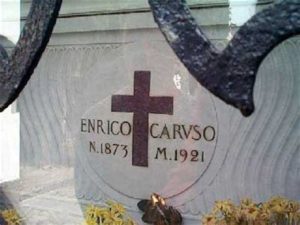 The Final Footprint – The King of Italy, Victor Emmanuel III, opened the Royal Basilica of the Church of San Francesco di Paola for Caruso’s funeral, which was attended by thousands of people. His embalmed body was preserved in a glass sarcophagus at Del Pianto Cemetery in Naples for mourners to view. His body was redressed each year with a new suit. In 1929, Dorothy Caruso had his remains sealed permanently in an ornate stone tomb. The famous Ajello Candle makers created a memorial candle for the opera singer towering over 18 feet tall and 8 feet in circumference and weighing one ton at the Church of Our Lady of Pompeii, made to last for 1800 years burning one day each year on the anniversary of Caruso’s birth.
The Final Footprint – The King of Italy, Victor Emmanuel III, opened the Royal Basilica of the Church of San Francesco di Paola for Caruso’s funeral, which was attended by thousands of people. His embalmed body was preserved in a glass sarcophagus at Del Pianto Cemetery in Naples for mourners to view. His body was redressed each year with a new suit. In 1929, Dorothy Caruso had his remains sealed permanently in an ornate stone tomb. The famous Ajello Candle makers created a memorial candle for the opera singer towering over 18 feet tall and 8 feet in circumference and weighing one ton at the Church of Our Lady of Pompeii, made to last for 1800 years burning one day each year on the anniversary of Caruso’s birth.
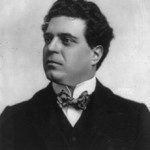 On this day in 1945, Italian composer most noted for his operas, Pietro Mascagni died in his apartment at the Hotel Plaza di Roma in Rome at the age of 82. His 1890 masterpiece Cavalleria rusticana caused one of the greatest sensations in opera history and single-handedly ushered in the Verismo movement in Italian dramatic music. His other operas L’amico Fritz and Iris have remained in the repertoire in Europe since their respective premieres. Mascagni reportedly said that at one point, Iris was performed in Italy more often than Cavalleria. Mascagni wrote fifteen operas, an operetta, several orchestral and vocal works, as well as songs and piano music. He enjoyed immense success during his lifetime, both as a composer and conductor of his own and other people’s music. He created a variety of styles in his operas: a Sicilian passion and warmth of Cavalleria, the exotic flavor of Iris, the idylls of L’amico Fritz and Lodoletta, the Gallic chiaroscuro of Isabeau, the steely, Veristic power of Il piccolo Marat, the over-ripe post-romanticism of the lush Parisina, which demonstrate a versatility.
On this day in 1945, Italian composer most noted for his operas, Pietro Mascagni died in his apartment at the Hotel Plaza di Roma in Rome at the age of 82. His 1890 masterpiece Cavalleria rusticana caused one of the greatest sensations in opera history and single-handedly ushered in the Verismo movement in Italian dramatic music. His other operas L’amico Fritz and Iris have remained in the repertoire in Europe since their respective premieres. Mascagni reportedly said that at one point, Iris was performed in Italy more often than Cavalleria. Mascagni wrote fifteen operas, an operetta, several orchestral and vocal works, as well as songs and piano music. He enjoyed immense success during his lifetime, both as a composer and conductor of his own and other people’s music. He created a variety of styles in his operas: a Sicilian passion and warmth of Cavalleria, the exotic flavor of Iris, the idylls of L’amico Fritz and Lodoletta, the Gallic chiaroscuro of Isabeau, the steely, Veristic power of Il piccolo Marat, the over-ripe post-romanticism of the lush Parisina, which demonstrate a versatility.
 The Final Footprint – Mascagni’s final resting place is at Cimitero Della Misercordia in Livorno, Italy. The 1980 Martin Scorsese film Raging Bull prominently features the following music: the Intermezzo from Cavalleria rusticana, the Barcarolle from Silvano, and the Intermezzo from Guglielmo Ratcliff (known as Il sogno di Ratcliff). The 1990 Francis Ford Coppola film The Godfather Part III used a production of Cavalleria rusticana at the Teatro Massimo to set its climax, with Michael Corleone’s son Anthony as Turiddu. The movie ends with the Intermezzo playing.
The Final Footprint – Mascagni’s final resting place is at Cimitero Della Misercordia in Livorno, Italy. The 1980 Martin Scorsese film Raging Bull prominently features the following music: the Intermezzo from Cavalleria rusticana, the Barcarolle from Silvano, and the Intermezzo from Guglielmo Ratcliff (known as Il sogno di Ratcliff). The 1990 Francis Ford Coppola film The Godfather Part III used a production of Cavalleria rusticana at the Teatro Massimo to set its climax, with Michael Corleone’s son Anthony as Turiddu. The movie ends with the Intermezzo playing.
#RIP #OTD in 1955 modernist poet (“The Auroras of Autumn”, “Anecdote of the Jar”, “Disillusionment of Ten O’Clock”, “The Emperor of Ice-Cream”, “The Idea of Order at Key West”, “Sunday Morning”, “The Snow Man”) Wallace Stevens died from stomach cancer in Hartford, Connecticut aged 75. Hartford’s Cedar Hill Cemetery
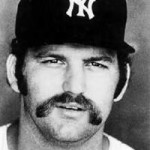 On this day in 1979, baseball player, catcher, New York
On this day in 1979, baseball player, catcher, New York Yankee, 2x World Series Champion, AL MVP, 7x All-Star, #15 retired, team captain, Thurman Munson died in a plane crash at the Akron-Canton Regional Airport in Ohio at the age of 32. Born Thurman Lee Munson on 7 June 1947 in Akron, Ohio. He played his entire 11-year career for the Yankees (1969–1979). Munson is the only Yankee ever to win both the Rookie of the Year and Most Valuable Player awards. Considered the “heart and soul” of the Yankees, Munson became the first team captain since Lou Gehrig. He led the Yankees to three consecutive World Series, winning two of them.
Yankee, 2x World Series Champion, AL MVP, 7x All-Star, #15 retired, team captain, Thurman Munson died in a plane crash at the Akron-Canton Regional Airport in Ohio at the age of 32. Born Thurman Lee Munson on 7 June 1947 in Akron, Ohio. He played his entire 11-year career for the Yankees (1969–1979). Munson is the only Yankee ever to win both the Rookie of the Year and Most Valuable Player awards. Considered the “heart and soul” of the Yankees, Munson became the first team captain since Lou Gehrig. He led the Yankees to three consecutive World Series, winning two of them.
 The Final Footprint – The day after his death, before the start of the Yankees’ four-game set with the Baltimore Orioles in the Bronx, the team paid tribute to their deceased captain in a pre-game ceremony in which the starters stood at their defensive positions, save for the catcher’s box, which remained empty. Following a prayer by Cardinal Terence Cooke, a moment of silence and “America The Beautiful” by Robert Merrill, the fans (announced attendance 51,151) burst into an eight minute standing ovation. Jerry Narron, the man who would replace Munson behind the plate that night, remained in the dugout and did not enter the field until stadium announcer Bob Sheppard said, “And now it is time to play ball. Thank you, ladies and gentlemen for your co-operation.” On August 6, the entire Yankee team attended Munson’s funeral in Canton, Ohio. Teammates Lou Piniella and Bobby Murcer, who were Munson’s best friends, gave eulogies. That night (before a national viewing audience on ABC’s Monday Night Baseball) the Yankees beat the Orioles 5–4 in New York, with Murcer driving in all five runs with a three-run home run in the seventh inning and a two-run single in the bottom of the ninth. Munson is interred in Sunset Hills Burial Park in Canton, Ohio. Yankee owner George Steinbrenner retired Munson’s number 15 immediately upon his catcher’s death. On 20 September 1980, a plaque dedicated to Munson’s memory was placed in Monument Park. The plaque bears excerpts from an inscription composed by Steinbrenner and flashed on the stadium scoreboard the day after his death:
The Final Footprint – The day after his death, before the start of the Yankees’ four-game set with the Baltimore Orioles in the Bronx, the team paid tribute to their deceased captain in a pre-game ceremony in which the starters stood at their defensive positions, save for the catcher’s box, which remained empty. Following a prayer by Cardinal Terence Cooke, a moment of silence and “America The Beautiful” by Robert Merrill, the fans (announced attendance 51,151) burst into an eight minute standing ovation. Jerry Narron, the man who would replace Munson behind the plate that night, remained in the dugout and did not enter the field until stadium announcer Bob Sheppard said, “And now it is time to play ball. Thank you, ladies and gentlemen for your co-operation.” On August 6, the entire Yankee team attended Munson’s funeral in Canton, Ohio. Teammates Lou Piniella and Bobby Murcer, who were Munson’s best friends, gave eulogies. That night (before a national viewing audience on ABC’s Monday Night Baseball) the Yankees beat the Orioles 5–4 in New York, with Murcer driving in all five runs with a three-run home run in the seventh inning and a two-run single in the bottom of the ninth. Munson is interred in Sunset Hills Burial Park in Canton, Ohio. Yankee owner George Steinbrenner retired Munson’s number 15 immediately upon his catcher’s death. On 20 September 1980, a plaque dedicated to Munson’s memory was placed in Monument Park. The plaque bears excerpts from an inscription composed by Steinbrenner and flashed on the stadium scoreboard the day after his death:
Our captain and leader has not left us, today, tomorrow, this year, next … Our endeavors will reflect our love and admiration for him.
Other notable Yankees whose final footprints include memorialization in Monument Park; Mel Allen, Lou Gehrig, Joe DiMaggio, Billy Martin, Babe Ruth, Bob Sheppard, Mickey Mantle, Roger Maris, Phil Rizzuto, George Steinbrenner, and Casey Stengel.
#RIP #OTD in 1988 short story writer (What We Talk About When We Talk About Love), poet (Gravy), Raymond Carver died in Port Angeles, Washington, from lung cancer at the age of 50. Ocean View Cemetery, Port Angeles, Washington
#RIP #OTD in 1990 University of Chicago professor, writer (A River Runs Through It and Other Stories, Young Men and Fire), Norman Maclean died in Chicago, at the age of 87. cremated remains scattered over the mountains of Montana
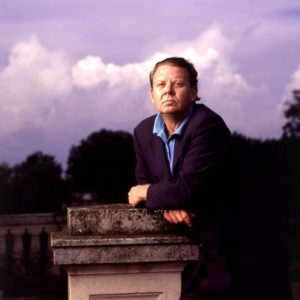 On this day in 1999 University of Texas in Austin graduate, writer and editor Willie Morris died from a heart attack in Jackson, Mississippi at the age of 64. Born William Weaks Morris on November 29, 1934 in Jackson, Mississippi. Perhaps best known for his lyrical prose style and reflections on the American South, particularly the Mississippi Delta and Yazoo City. In 1967 he became the youngest editor of Harper’s Magazine. He wrote several works of fiction and non-fiction, including his seminal book North Toward Home, as well as My Dog Skip.
On this day in 1999 University of Texas in Austin graduate, writer and editor Willie Morris died from a heart attack in Jackson, Mississippi at the age of 64. Born William Weaks Morris on November 29, 1934 in Jackson, Mississippi. Perhaps best known for his lyrical prose style and reflections on the American South, particularly the Mississippi Delta and Yazoo City. In 1967 he became the youngest editor of Harper’s Magazine. He wrote several works of fiction and non-fiction, including his seminal book North Toward Home, as well as My Dog Skip.
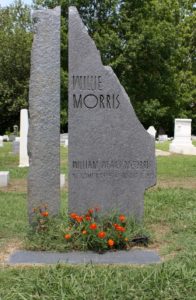
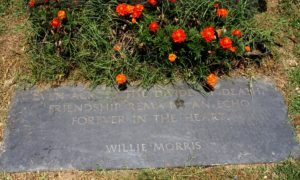
The Final Footprint
Willie Morris is buried in Glenwood Cemetery in Yazoo City, close to the “grave” of the fictitious Witch of Yazoo, a character from one of Morris’ books, Good Old Boy: A Delta Boyhood.
#RIP #OTD in 2022 sportscaster, play-by-play announcer for the Brooklyn / Los Angeles Dodgers Vin Scully died at his home in Hidden Hills, California, at the age of 94. Cremation
Have you planned yours yet?
Follow TFF on twitter @RIPTFF
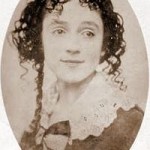 On this day in 1868, actress, painter and poet, said by some to be the “first American Jewish superstar”, the Menken, Adah Isaacs Menken died in Paris at the age of 33 from of peritonitis and tuberculosis. She died after having just written a friend:
On this day in 1868, actress, painter and poet, said by some to be the “first American Jewish superstar”, the Menken, Adah Isaacs Menken died in Paris at the age of 33 from of peritonitis and tuberculosis. She died after having just written a friend: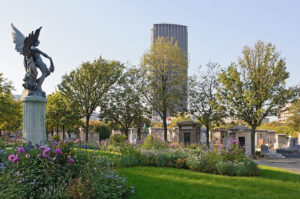 The Final Footprint – The Menken’s final resting place is in Cimetière de Montparnasse in Paris. Other notable Final Footprints at Montparnasse include; Charles Baudelaire, Samuel Beckett, Simone de Beauvoir, Emmanuel Chabrier, Marguerite Duras, Henri Fantin-Latour, César Franck, André Lhote, Guy de Maupassant, Camille Saint-Saëns, Jean-Paul Sartre, Jean Seberg, and Susan Sontag.
The Final Footprint – The Menken’s final resting place is in Cimetière de Montparnasse in Paris. Other notable Final Footprints at Montparnasse include; Charles Baudelaire, Samuel Beckett, Simone de Beauvoir, Emmanuel Chabrier, Marguerite Duras, Henri Fantin-Latour, César Franck, André Lhote, Guy de Maupassant, Camille Saint-Saëns, Jean-Paul Sartre, Jean Seberg, and Susan Sontag.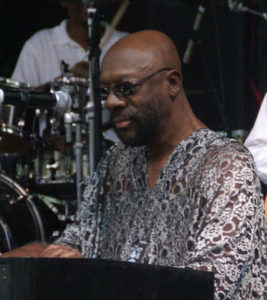 On this day in 2008, humanitarian, songwriter, musician, singer and actor, Academy Award-winner, Grammy Award-winner, Isaac Hayes died at his home near Memphis from a stroke at the age of 65. Born Isaac Lee Hayes on 20 August 1942 in Covington, Tennessee. My favorite songs written or co-written by Hayes include; “Soul Man” co-written with David Porter, “Hold On I’m Comin'” co-written with Porter, “I Thank You” co-written with Porter, and “Theme from Shaft” which Hayes won an Academy Award for Best Original Song. Hayes was married four times.
On this day in 2008, humanitarian, songwriter, musician, singer and actor, Academy Award-winner, Grammy Award-winner, Isaac Hayes died at his home near Memphis from a stroke at the age of 65. Born Isaac Lee Hayes on 20 August 1942 in Covington, Tennessee. My favorite songs written or co-written by Hayes include; “Soul Man” co-written with David Porter, “Hold On I’m Comin'” co-written with Porter, “I Thank You” co-written with Porter, and “Theme from Shaft” which Hayes won an Academy Award for Best Original Song. Hayes was married four times. The Final Footprint – Hayes is interred in Memorial Park Cemetery in Memphis. His grave is marked by a full ledger flat bronze on granite marker. The inscription is as follows: God looked around his garden And he found an empty place He then looked down upon this earth And found your star He put his arms around you And lifted you to rest God’s garden is beautiful now He always takes the best But when you left THE BIGGEST PART OF ME LEFT But thanks for leaving a part of us in KOJO The hardest thing always was for you to say goodbye So I won’t either One day we’ll be together again LOVING YOU WAS THE GREATEST THING I’VE EVER EXPERIENCED YOU’LL ALWAYS BE IN MY HEART My Love, Your wife ADJOWA “MARGARET” HAYES. Other notable final footprints at Memorial Park include; Bobby “Blue” Bland, Sam Phillips, Charlie Rich, and Bob Welch.
The Final Footprint – Hayes is interred in Memorial Park Cemetery in Memphis. His grave is marked by a full ledger flat bronze on granite marker. The inscription is as follows: God looked around his garden And he found an empty place He then looked down upon this earth And found your star He put his arms around you And lifted you to rest God’s garden is beautiful now He always takes the best But when you left THE BIGGEST PART OF ME LEFT But thanks for leaving a part of us in KOJO The hardest thing always was for you to say goodbye So I won’t either One day we’ll be together again LOVING YOU WAS THE GREATEST THING I’VE EVER EXPERIENCED YOU’LL ALWAYS BE IN MY HEART My Love, Your wife ADJOWA “MARGARET” HAYES. Other notable final footprints at Memorial Park include; Bobby “Blue” Bland, Sam Phillips, Charlie Rich, and Bob Welch.
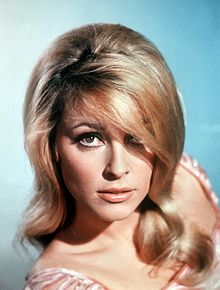 On this day in 1969 actress Sharon Tate and her unborn son were murdered in her home in Benedict Canyon, Los Angeles by followers of Charles Manson. Tate was 26. Born Sharon Marie Tate on 24 January 1943 in Dallas, Texas. Also killed were Tate’s friends, Jay Sebring, Abigail Folger, Steven Parent and Wojiech “Voytek” Frykowski. The murders were one of the defining moments of the ’60’s. One could say that the ’60’s ended abruptly that night. During the 1960s she played small television roles before appearing in several motion pictures. She also appeared regularly in fashion magazines as a model and cover girl. After receiving positive reviews for her comedic and dramatic performances, Tate was hailed as one of Hollywood’s most promising newcomers. She made her film debut in the occult-themed Eye of the Devil (1966), which was produced by Martin Ransohoff. Tate also starred as Jennifer North in the cult classic, Valley of the Dolls (1967), which earned her a Golden Globe Award nomination. Tate was married to director Roman Polanski (1968-1969 her death).
On this day in 1969 actress Sharon Tate and her unborn son were murdered in her home in Benedict Canyon, Los Angeles by followers of Charles Manson. Tate was 26. Born Sharon Marie Tate on 24 January 1943 in Dallas, Texas. Also killed were Tate’s friends, Jay Sebring, Abigail Folger, Steven Parent and Wojiech “Voytek” Frykowski. The murders were one of the defining moments of the ’60’s. One could say that the ’60’s ended abruptly that night. During the 1960s she played small television roles before appearing in several motion pictures. She also appeared regularly in fashion magazines as a model and cover girl. After receiving positive reviews for her comedic and dramatic performances, Tate was hailed as one of Hollywood’s most promising newcomers. She made her film debut in the occult-themed Eye of the Devil (1966), which was produced by Martin Ransohoff. Tate also starred as Jennifer North in the cult classic, Valley of the Dolls (1967), which earned her a Golden Globe Award nomination. Tate was married to director Roman Polanski (1968-1969 her death).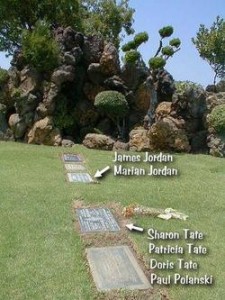 The Final Footprint – Tate and her son were interred together in Saint Ann’s Section in Holy Cross Cemetery in Culver City, California. Later, her mother Doris (1992) and her sister Patricia (2000) were interred near them. Their graves are marked by an engraved flat granite marker. Sharon’s term of endearment is; OUR LOVING DAUGHTER & BELOVED WIFE OF ROMAN. Other notable final footprints at Holy Cross include; John Candy, Bing Crosby, Jimmy Durante, John Ford, Rita Hayworth, Mario Lanza, Bela Lugosi, Al Martino, Audrey Meadows, Ricardo Montalbán, Hermes Pan, Chris Penn, Jean Peters, and Jo Stafford. Tate’s biographer, Greg King, wrote in Sharon Tate and the Manson Murders (2000): “Sharon’s real legacy lies not in her movies or in her television work. The very fact that, today, victims or their families in California are able to sit before those convicted of a crime and have a voice in the sentencing at trials or at parole hearings, is largely due to the work of Doris [and Patti] Tate. Their years of devotion to Sharon’s memory and dedication to victims’ rights… have helped transform Sharon from mere victim, [and] restore a human face to one of the twentieth century’s most infamous crimes.”
The Final Footprint – Tate and her son were interred together in Saint Ann’s Section in Holy Cross Cemetery in Culver City, California. Later, her mother Doris (1992) and her sister Patricia (2000) were interred near them. Their graves are marked by an engraved flat granite marker. Sharon’s term of endearment is; OUR LOVING DAUGHTER & BELOVED WIFE OF ROMAN. Other notable final footprints at Holy Cross include; John Candy, Bing Crosby, Jimmy Durante, John Ford, Rita Hayworth, Mario Lanza, Bela Lugosi, Al Martino, Audrey Meadows, Ricardo Montalbán, Hermes Pan, Chris Penn, Jean Peters, and Jo Stafford. Tate’s biographer, Greg King, wrote in Sharon Tate and the Manson Murders (2000): “Sharon’s real legacy lies not in her movies or in her television work. The very fact that, today, victims or their families in California are able to sit before those convicted of a crime and have a voice in the sentencing at trials or at parole hearings, is largely due to the work of Doris [and Patti] Tate. Their years of devotion to Sharon’s memory and dedication to victims’ rights… have helped transform Sharon from mere victim, [and] restore a human face to one of the twentieth century’s most infamous crimes.”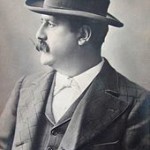 On this day in 1919, opera composer, Ruggero Leoncavallo died in Montecatini Terme, Tuscany at the age of 62. Born Ruggero Giacomo Maria Giuseppe Emmanuele Raffaele Domenico Vincenzo Francesco Donato Leoncavallo in Naples on 23 April 1857. His two-act work Pagliacci remains one of the most popular works in the opera repertory. Pagliacci premiered at the Teatro Dal Verme in Milan on 21 May 1892. Leoncavallo was the librettist for most of his own operas. In my opinion, he is one of the greatest Italian librettist of his time after Boito. Among Leoncavallo’s libretti for other composers is his contribution to the libretto for Giacomo Puccini’s Manon Lescaut. His other well-known works include the song “Mattinata”, popularized by Enrico Caruso, as well as the symphonic poem La nuit de mai.
On this day in 1919, opera composer, Ruggero Leoncavallo died in Montecatini Terme, Tuscany at the age of 62. Born Ruggero Giacomo Maria Giuseppe Emmanuele Raffaele Domenico Vincenzo Francesco Donato Leoncavallo in Naples on 23 April 1857. His two-act work Pagliacci remains one of the most popular works in the opera repertory. Pagliacci premiered at the Teatro Dal Verme in Milan on 21 May 1892. Leoncavallo was the librettist for most of his own operas. In my opinion, he is one of the greatest Italian librettist of his time after Boito. Among Leoncavallo’s libretti for other composers is his contribution to the libretto for Giacomo Puccini’s Manon Lescaut. His other well-known works include the song “Mattinata”, popularized by Enrico Caruso, as well as the symphonic poem La nuit de mai.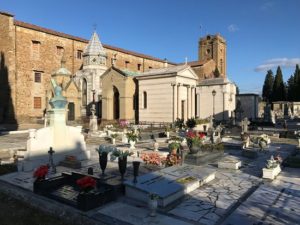 The Final Footprint – His funeral was held two days later, with hundreds in attendance, including fellow composer Pietro Mascagni and Puccini. His final resting place is the Cimitero Monumentale Delle Porte Sante Florence Toscana, Italy.
The Final Footprint – His funeral was held two days later, with hundreds in attendance, including fellow composer Pietro Mascagni and Puccini. His final resting place is the Cimitero Monumentale Delle Porte Sante Florence Toscana, Italy.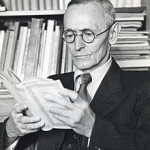 On this day in 1962, German-Swiss poet, novelist, and painter, Nobel Prize laureate, Hermann Hesse died at the age of 85 in Montagnola, Switzerland. Born on 2 July 1877 in the Black Forest town of Calw in Württemberg, Germany. His best-known works include Steppenwolf, Siddhartha, and The Glass Bead Game, each of which explores an individual’s search for authenticity, self-knowledge and spirituality.
On this day in 1962, German-Swiss poet, novelist, and painter, Nobel Prize laureate, Hermann Hesse died at the age of 85 in Montagnola, Switzerland. Born on 2 July 1877 in the Black Forest town of Calw in Württemberg, Germany. His best-known works include Steppenwolf, Siddhartha, and The Glass Bead Game, each of which explores an individual’s search for authenticity, self-knowledge and spirituality.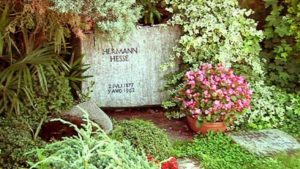 The Final Footprint – Hesse was buried in the cemetery at San Abbondio in Montagnola.
The Final Footprint – Hesse was buried in the cemetery at San Abbondio in Montagnola.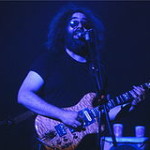 On this day in 1995, musician, singer, songwriter, member of the Grateful Dead, Jerry Garcia died in his room at the Serenity Knolls treatment center in Forest Knolls, California, from a heart attack at the age of 53. Born Jerome John Garcia on 1 August 1942 San Francisco. Garcia performed with the Grateful Dead for their entire thirty-year career (1965–1995). Garcia also founded and participated in a variety of side projects, including the Saunders-Garcia Band (with longtime friend Merl Saunders), Jerry Garcia Band, Old and in the Way, the Garcia/Grisman acoustic duo, Legion of Mary, and the New Riders of the Purple Sage (which Garcia co-founded with John Dawson and David Nelson). He also released several solo albums, and contributed to a number of albums by other artists over the years as a session musician. He was well known his distinctive guitar playing.
On this day in 1995, musician, singer, songwriter, member of the Grateful Dead, Jerry Garcia died in his room at the Serenity Knolls treatment center in Forest Knolls, California, from a heart attack at the age of 53. Born Jerome John Garcia on 1 August 1942 San Francisco. Garcia performed with the Grateful Dead for their entire thirty-year career (1965–1995). Garcia also founded and participated in a variety of side projects, including the Saunders-Garcia Band (with longtime friend Merl Saunders), Jerry Garcia Band, Old and in the Way, the Garcia/Grisman acoustic duo, Legion of Mary, and the New Riders of the Purple Sage (which Garcia co-founded with John Dawson and David Nelson). He also released several solo albums, and contributed to a number of albums by other artists over the years as a session musician. He was well known his distinctive guitar playing. On this day in 2008
On this day in 2008  The Final Footprint
The Final Footprint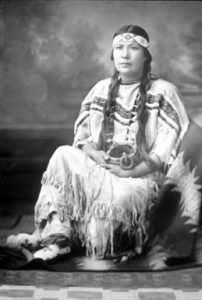 On this day in 1936, Native American author, Mourning Dove died at the state hospital in Medical Lake, Washington at the approximate age of 48. Perhaps best known for her novel Cogewea the Half-Blood: A Depiction of the Great Montana Cattle Range (1927). Born Hum-isha-ma “in the Moon of Leaves” (April) 1888 in a canoe on the Kootenai River near Bonners Ferry, Idaho , her name was later changed to Christal Quintasket.
On this day in 1936, Native American author, Mourning Dove died at the state hospital in Medical Lake, Washington at the approximate age of 48. Perhaps best known for her novel Cogewea the Half-Blood: A Depiction of the Great Montana Cattle Range (1927). Born Hum-isha-ma “in the Moon of Leaves” (April) 1888 in a canoe on the Kootenai River near Bonners Ferry, Idaho , her name was later changed to Christal Quintasket.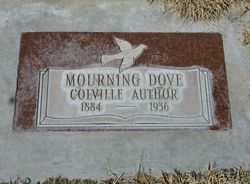 The Final Footprint – She is interred in Omak Memorial Cemetery in Omak, Washington.
The Final Footprint – She is interred in Omak Memorial Cemetery in Omak, Washington.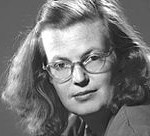 On this day in 1965, writer, novelist, Shirley Jackson died of heart failure in her sleep at her home in North Bennington, Vermont at the age of 48. Born Shirley Hardie Jackson on 14 December 1916 in San Francisco. Perhaps best known for the short story “The Lottery” (1948), which suggests a secret, sinister underside to bucolic small-town America. She is also well known for the 1959 novel The Haunting of Hill House.
On this day in 1965, writer, novelist, Shirley Jackson died of heart failure in her sleep at her home in North Bennington, Vermont at the age of 48. Born Shirley Hardie Jackson on 14 December 1916 in San Francisco. Perhaps best known for the short story “The Lottery” (1948), which suggests a secret, sinister underside to bucolic small-town America. She is also well known for the 1959 novel The Haunting of Hill House.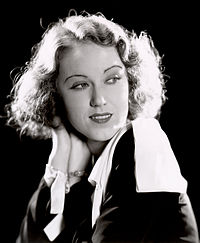 On this day in 2004, actress Fay Wray died in her Manhattan apartment at the age of 96. Born Vina Fay Wray on 15 September 1907 on a ranch near Cardston, Alberta, Canada. Perhaps best remembered for her role as Ann Darrow in the film King Kong (1933). Wray married three times; John Monk Saunders (1928-1939 divorce), Robert Riskin (1942-1955 his death) and Sanford Rothenberg (1971-1991 his death).
On this day in 2004, actress Fay Wray died in her Manhattan apartment at the age of 96. Born Vina Fay Wray on 15 September 1907 on a ranch near Cardston, Alberta, Canada. Perhaps best remembered for her role as Ann Darrow in the film King Kong (1933). Wray married three times; John Monk Saunders (1928-1939 divorce), Robert Riskin (1942-1955 his death) and Sanford Rothenberg (1971-1991 his death). The Final Footprint – Wray is interred in Hollywood Forever Cemetery in Hollywood. Her grave is marked by an individual engraved flat granite marker near a memorial bench. The marker is engraved with her name and her birth and death years. Two days after her death, the lights of the Empire State Building were extinguished for 15 minutes in her memory. For her contribution to the motion picture industry, Wray was honored with a star on the Hollywood Walk of Fame at 6349 Hollywood Blvd. She received a star posthumously on Canada’s Walk of Fame in Toronto on June 5, 2005. A park near Lee’s Creek on Main Street in Cardston was named “Fay Wray Park” in her honor. The sign at the edge of the park on Main Street has a silhouette of King Kong on it. A large oil portrait of Wray by Alberta artist Neil Boyle is on display in the Empress Theatre in Fort Macleod, Alberta. Other notable Final Footprints at Hollywood Forever include; Mel Blanc, Lana Clarkson, Iron Eyes Cody, Chris Cornell, Cecil B. DeMille, Victor Fleming, Judy Garland, Joan Hackett, John Huston, Hattie McDaniel’s cenotaph, Jayne Mansfield’s cenotaph, Tyrone Power, Dee Dee Ramone, Johnny Ramone, Virginia Rappe, Nelson Riddle, Mickey Rooney, Ann Sheridan, Bugsy Siegel, Rudolph Valentino, and Anton Yelchin.
The Final Footprint – Wray is interred in Hollywood Forever Cemetery in Hollywood. Her grave is marked by an individual engraved flat granite marker near a memorial bench. The marker is engraved with her name and her birth and death years. Two days after her death, the lights of the Empire State Building were extinguished for 15 minutes in her memory. For her contribution to the motion picture industry, Wray was honored with a star on the Hollywood Walk of Fame at 6349 Hollywood Blvd. She received a star posthumously on Canada’s Walk of Fame in Toronto on June 5, 2005. A park near Lee’s Creek on Main Street in Cardston was named “Fay Wray Park” in her honor. The sign at the edge of the park on Main Street has a silhouette of King Kong on it. A large oil portrait of Wray by Alberta artist Neil Boyle is on display in the Empress Theatre in Fort Macleod, Alberta. Other notable Final Footprints at Hollywood Forever include; Mel Blanc, Lana Clarkson, Iron Eyes Cody, Chris Cornell, Cecil B. DeMille, Victor Fleming, Judy Garland, Joan Hackett, John Huston, Hattie McDaniel’s cenotaph, Jayne Mansfield’s cenotaph, Tyrone Power, Dee Dee Ramone, Johnny Ramone, Virginia Rappe, Nelson Riddle, Mickey Rooney, Ann Sheridan, Bugsy Siegel, Rudolph Valentino, and Anton Yelchin.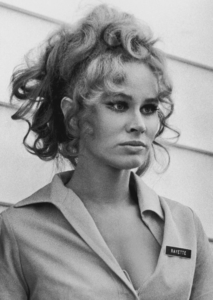 On this day in 2013 actress, screenwriter, singer, and songwriter Karen Black died from ampullary cancer in Los Angeles at the age of 74. Born Karen Blanche Ziegler on July 1, 1939 in Park Ridge, Illinois. Black studied acting in New York City and performed on Broadway before making her major film debut in Francis Ford Coppola’s You’re a Big Boy Now (1966).
On this day in 2013 actress, screenwriter, singer, and songwriter Karen Black died from ampullary cancer in Los Angeles at the age of 74. Born Karen Blanche Ziegler on July 1, 1939 in Park Ridge, Illinois. Black studied acting in New York City and performed on Broadway before making her major film debut in Francis Ford Coppola’s You’re a Big Boy Now (1966).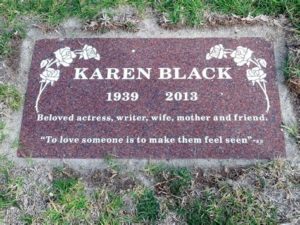 The Final Footprint
The Final Footprint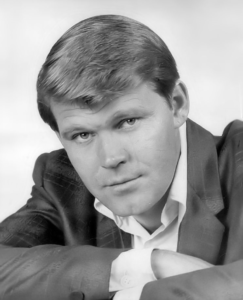 On this day in 2017 singer, guitarist, songwriter, and actor Glen Camplbell died from Alzheimer’s complications in Nashville at the age of 81. Born Glen Travis Campbell on April 22, 1936 in Billstown, Arkansas. Perhaps best known for a series of hit songs in the 1960s and 1970s, and for hosting a music and comedy variety show called The Glen Campbell Goodtime Hour from January 1969 through June 1972. He released over 70 albums in a career that spanned five decades, accumulating over 45 million record sales worldwide, including 12 gold albums, four platinum albums, and one double-platinum album.
On this day in 2017 singer, guitarist, songwriter, and actor Glen Camplbell died from Alzheimer’s complications in Nashville at the age of 81. Born Glen Travis Campbell on April 22, 1936 in Billstown, Arkansas. Perhaps best known for a series of hit songs in the 1960s and 1970s, and for hosting a music and comedy variety show called The Glen Campbell Goodtime Hour from January 1969 through June 1972. He released over 70 albums in a career that spanned five decades, accumulating over 45 million record sales worldwide, including 12 gold albums, four platinum albums, and one double-platinum album.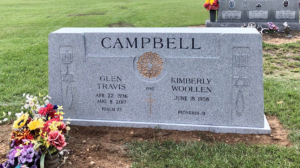 The Final Footprint
The Final Footprint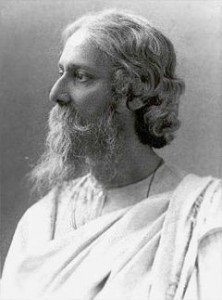 On this day in 1941, Bengali poet, novelist, musician, painter and playwright, Nobel Prize recipient, The Shakespeare of India, The Bard of Bengal, Rabindranath Tagore died in an upstairs room of the Jorasanko mansion in which he was raised in Calcutta, at the age of 80. Born on 7 May 1861. He wrote one of my favorite poems, Unending Love, which Gregory Peck read on camera after Audrey Hepburn’s death.
On this day in 1941, Bengali poet, novelist, musician, painter and playwright, Nobel Prize recipient, The Shakespeare of India, The Bard of Bengal, Rabindranath Tagore died in an upstairs room of the Jorasanko mansion in which he was raised in Calcutta, at the age of 80. Born on 7 May 1861. He wrote one of my favorite poems, Unending Love, which Gregory Peck read on camera after Audrey Hepburn’s death.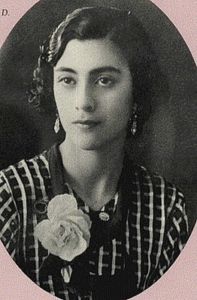 On this day in 1974, poet and author Rosario Castellanos died
On this day in 1974, poet and author Rosario Castellanos died 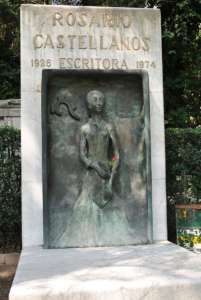 The Final Footprint
The Final Footprint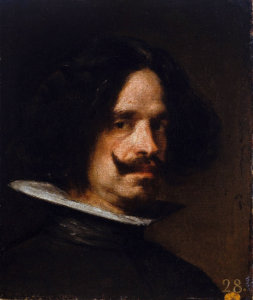 On this day in 1660, artist Diego Velázquez died in Madrid at the age of 61. Baptized Diego Rodríguez de Silva y Velázquez on June 6, 1599 in Seville. He was the leading artist in the court of King Philip IV, and in my opinion, one of the most important painters of the Spanish Golden Age. He was an individualistic artist of the contemporary Baroque period. In addition to numerous renditions of scenes of historical and cultural significance, he painted portraits of the Spanish royal family, other notable European figures, and commoners, culminating in the production of his masterpiece Las Meninas (1656).
On this day in 1660, artist Diego Velázquez died in Madrid at the age of 61. Baptized Diego Rodríguez de Silva y Velázquez on June 6, 1599 in Seville. He was the leading artist in the court of King Philip IV, and in my opinion, one of the most important painters of the Spanish Golden Age. He was an individualistic artist of the contemporary Baroque period. In addition to numerous renditions of scenes of historical and cultural significance, he painted portraits of the Spanish royal family, other notable European figures, and commoners, culminating in the production of his masterpiece Las Meninas (1656).






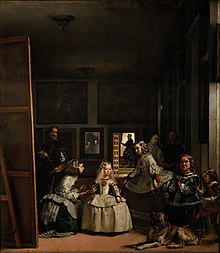


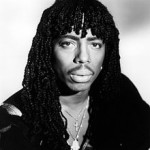 On this day in 2004, singer, songwriter, musician and record producer, Rick James died at the age of 56 in his Los Angeles home at the Oakwood apartment complex on Barham Boulevard from pulmonary failure and cardiac failure. Born James Ambrose Johnson, Jr. on 19 February 1948 in Buffalo, New York. Perhaps best known for being a major popularizer of funk music in the late 1970s and early 1980s thanks to million-selling hits such as “You and I” (1978), “Give It to Me Baby” (1981) and “Super Freak” (1981), the latter song crossing him over to pop audiences and selling over three million copies. It later contributed to the success of rapper MC Hammer’s “U Can’t Touch This” (1990), for which James sued him, in order to be credited. James won a Grammy Award for Best R&B Song with Hammer for the song, his only Grammy win.
On this day in 2004, singer, songwriter, musician and record producer, Rick James died at the age of 56 in his Los Angeles home at the Oakwood apartment complex on Barham Boulevard from pulmonary failure and cardiac failure. Born James Ambrose Johnson, Jr. on 19 February 1948 in Buffalo, New York. Perhaps best known for being a major popularizer of funk music in the late 1970s and early 1980s thanks to million-selling hits such as “You and I” (1978), “Give It to Me Baby” (1981) and “Super Freak” (1981), the latter song crossing him over to pop audiences and selling over three million copies. It later contributed to the success of rapper MC Hammer’s “U Can’t Touch This” (1990), for which James sued him, in order to be credited. James won a Grammy Award for Best R&B Song with Hammer for the song, his only Grammy win.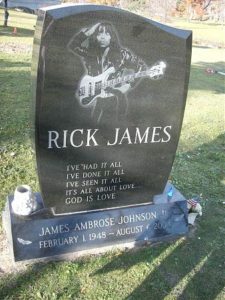 The Final Footprint – James is interred in Forest Lawn Cemetery in Buffalo.
The Final Footprint – James is interred in Forest Lawn Cemetery in Buffalo.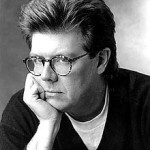 On this day in 2009, film director, producer and screenwriter, John Hughes died at the age of 59 of a heart attack while walking in Manhattan where he was visiting his family. Born John Wilden Hughes, Jr. on 18 February 1950 in Lansing, Michigan. He directed or scripted some of the most successful films of the 1980s and 1990s, including National Lampoon’s Vacation, Ferris Bueller’s Day Off, Weird Science, The Breakfast Club, Some Kind of Wonderful, Sixteen Candles, Pretty in Pink, Planes, Trains and Automobiles, Uncle Buck, Home Alone, and Home Alone 2: Lost in New York.
On this day in 2009, film director, producer and screenwriter, John Hughes died at the age of 59 of a heart attack while walking in Manhattan where he was visiting his family. Born John Wilden Hughes, Jr. on 18 February 1950 in Lansing, Michigan. He directed or scripted some of the most successful films of the 1980s and 1990s, including National Lampoon’s Vacation, Ferris Bueller’s Day Off, Weird Science, The Breakfast Club, Some Kind of Wonderful, Sixteen Candles, Pretty in Pink, Planes, Trains and Automobiles, Uncle Buck, Home Alone, and Home Alone 2: Lost in New York. The Final Footprint – Hughes is interred in Lake Forest Cemetery in Lake Forest, Illinois.
The Final Footprint – Hughes is interred in Lake Forest Cemetery in Lake Forest, Illinois.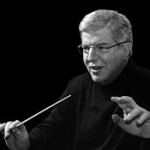 On this day in 2012, composer, conductor, an EGOT (those who have been awarded an Emmy, Grammy, Oscar, and Tony), Pulitzer Prize recipient, Marvin Hamlisch died in Los Angeles, California at age 68, following a short illness, primarily due to respiratory arrest caused by a combination of anoxic brain encephalopathy and hypertension. Born Marvin Frederick Hamlisch on 2 June 1944 in Manhattan. Hamlisch married Terre Blair (1989 – 2012 his death. His prior relationship with lyricist Carole Bayer Sager inspired the musical They’re Playing Our Song.
On this day in 2012, composer, conductor, an EGOT (those who have been awarded an Emmy, Grammy, Oscar, and Tony), Pulitzer Prize recipient, Marvin Hamlisch died in Los Angeles, California at age 68, following a short illness, primarily due to respiratory arrest caused by a combination of anoxic brain encephalopathy and hypertension. Born Marvin Frederick Hamlisch on 2 June 1944 in Manhattan. Hamlisch married Terre Blair (1989 – 2012 his death. His prior relationship with lyricist Carole Bayer Sager inspired the musical They’re Playing Our Song.
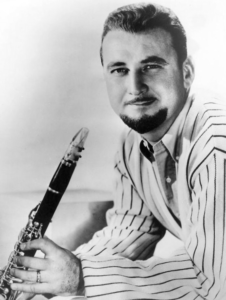 On this day in 2016, jazz clarinetist Pete Fountain died from heart failure in New Orleans at the age of 86. Born Pierre Dewey LaFontaine, Jr. on July 3, 1930 in New Orleans. He played in traditional and contemporary genres of jazz, such as Dixieland, pop jazz, honky-tonk jazz, as well as pop, and Creole music.
On this day in 2016, jazz clarinetist Pete Fountain died from heart failure in New Orleans at the age of 86. Born Pierre Dewey LaFontaine, Jr. on July 3, 1930 in New Orleans. He played in traditional and contemporary genres of jazz, such as Dixieland, pop jazz, honky-tonk jazz, as well as pop, and Creole music.
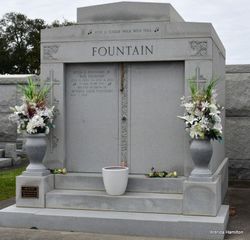 The Final Footprint
The Final Footprint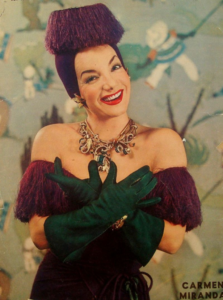
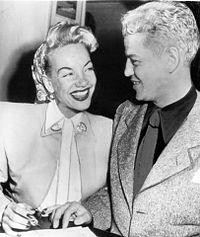

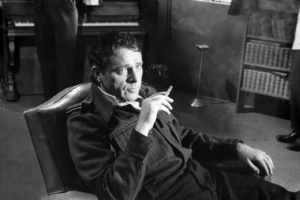
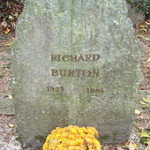 The Final Footprint – Burton is interred in Vieux Cemetery, Celigny, Switzerland, in a red suit, a tribute to his Welsh roots, and with a copy of Dylan Thomas’ poems. He and Taylor had discussed being buried together. His widow Sally purchased the plot next to Burton’s to ensure she would be buried next to him.
The Final Footprint – Burton is interred in Vieux Cemetery, Celigny, Switzerland, in a red suit, a tribute to his Welsh roots, and with a copy of Dylan Thomas’ poems. He and Taylor had discussed being buried together. His widow Sally purchased the plot next to Burton’s to ensure she would be buried next to him. 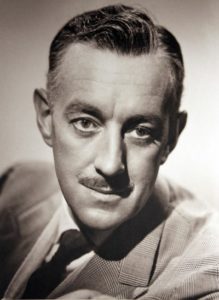


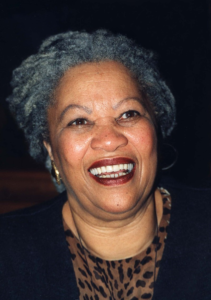 On this day in 2019,
On this day in 2019, 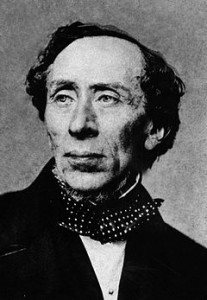
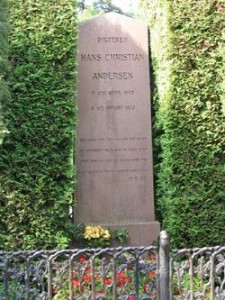
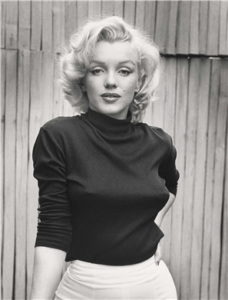
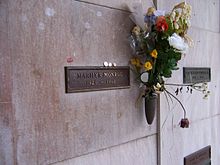
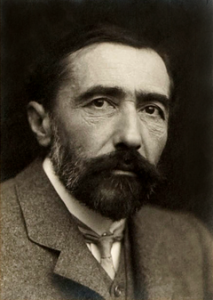 On this day in 1924 novelist Joseph Conrad died of a heart attack in Bishopsbourne, England at the age of 66. Born Józef Teodor Konrad Korzeniowski on 3 December 1857 in Berdichev (Polish: Berdyczów), Kiev Governorate (now Berdychiv, Ukraine). In my opionion, one of the great novelists in English. His stories and novels feature predominantly nautical or seaboard settings and depict trials of the human spirit that plumb the depths of the human soul. I like that some of his works have a strain of romanticism. Perhaps his best known works are Lord Jim (1899-1900) and Heart of Darkness (1902). Conrad married Jessie George (1896-1924 his death).
On this day in 1924 novelist Joseph Conrad died of a heart attack in Bishopsbourne, England at the age of 66. Born Józef Teodor Konrad Korzeniowski on 3 December 1857 in Berdichev (Polish: Berdyczów), Kiev Governorate (now Berdychiv, Ukraine). In my opionion, one of the great novelists in English. His stories and novels feature predominantly nautical or seaboard settings and depict trials of the human spirit that plumb the depths of the human soul. I like that some of his works have a strain of romanticism. Perhaps his best known works are Lord Jim (1899-1900) and Heart of Darkness (1902). Conrad married Jessie George (1896-1924 his death).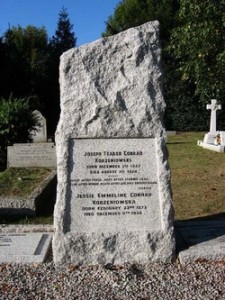 The Final Footprint – Conrad is interred in Canterbury City Cemetery in Canterbury, Kent, England. Jessie was interred next to him after her death on 3 December 1936. Their graves are marked with a large upright companion granite marker with the epitaph by the English poet Edmund Spenser; SLEEP AFTER TOYLE, PORT AFTER STORMIE SEAS, EASE AFTER WARRE, DEATH AFTER LIFE, DOES GREATLY PLEASE. SPENSER
The Final Footprint – Conrad is interred in Canterbury City Cemetery in Canterbury, Kent, England. Jessie was interred next to him after her death on 3 December 1936. Their graves are marked with a large upright companion granite marker with the epitaph by the English poet Edmund Spenser; SLEEP AFTER TOYLE, PORT AFTER STORMIE SEAS, EASE AFTER WARRE, DEATH AFTER LIFE, DOES GREATLY PLEASE. SPENSER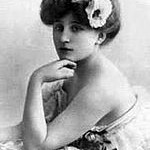 On this day in 1954, French novelist and performer, Colette died in Paris at the age of 81. Born Sidonie-Gabrielle Colette on 28 January 1873 in Saint-Sauveur-en-Puisaye, Yonne, in the Burgundy Region of France. Perhpaps best known for her novel Gigi, upon which Lerner and Loewe based the stage and film musical comedies of the same title. Colette is directly credited with the discovery of a young, nascent Audrey Hepburn, who she chose on sight to play the eponymous Broadway lead in Gigi. She was the first woman given a state funeral in France, although she was refused Roman Catholic rites because of her divorces.
On this day in 1954, French novelist and performer, Colette died in Paris at the age of 81. Born Sidonie-Gabrielle Colette on 28 January 1873 in Saint-Sauveur-en-Puisaye, Yonne, in the Burgundy Region of France. Perhpaps best known for her novel Gigi, upon which Lerner and Loewe based the stage and film musical comedies of the same title. Colette is directly credited with the discovery of a young, nascent Audrey Hepburn, who she chose on sight to play the eponymous Broadway lead in Gigi. She was the first woman given a state funeral in France, although she was refused Roman Catholic rites because of her divorces.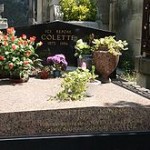 The Final Footprint – Colette is interred in Père Lachaise Cemetery in Paris. Other notable Final Footprints at Père Lachaise include; Guillaume Apollinaire, Georges Bizet, Honoré de Balzac, Jean-Dominique Bauby, Maria Callas, Frédéric Chopin, Auguste Comte, Jean-Baptiste-Camille Corot, Max Ernst, Molière, Jim Morrison, Édith Piaf, Camille Pissarro, Marcel Proust, Sully Prudhomme, Gioachino Rossini, Georges-Pierre Seurat, Gertrude Stein, Dorothea Tanning, Alice B. Toklas, Oscar Wilde, and Richard Wright.
The Final Footprint – Colette is interred in Père Lachaise Cemetery in Paris. Other notable Final Footprints at Père Lachaise include; Guillaume Apollinaire, Georges Bizet, Honoré de Balzac, Jean-Dominique Bauby, Maria Callas, Frédéric Chopin, Auguste Comte, Jean-Baptiste-Camille Corot, Max Ernst, Molière, Jim Morrison, Édith Piaf, Camille Pissarro, Marcel Proust, Sully Prudhomme, Gioachino Rossini, Georges-Pierre Seurat, Gertrude Stein, Dorothea Tanning, Alice B. Toklas, Oscar Wilde, and Richard Wright.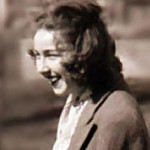 On this day in 1964, writer and important voice in American literature, Flannery O’Connor died at the age of 39, of complications from lupus, at Baldwin County Hospital in Milledgeville, Georgia. Born Mary Flannery O’Connor on 25 March 1925 in Savannah, Georgia. Her two novels were Wise Blood (1952) and The Violent Bear It Away (1960). She also published two books of short stories: A Good Man Is Hard to Find (1955) and Everything That Rises Must Converge (published posthumously in 1965). She was a Southern writer who often wrote in a Southern Gothic style and relied heavily on regional settings and grotesque characters. O’Connor’s writing also reflected her own Roman Catholic faith, and frequently examined questions of morality and ethics. One of my very favorite writers. Each year on her birthday I read one of her short stories.
On this day in 1964, writer and important voice in American literature, Flannery O’Connor died at the age of 39, of complications from lupus, at Baldwin County Hospital in Milledgeville, Georgia. Born Mary Flannery O’Connor on 25 March 1925 in Savannah, Georgia. Her two novels were Wise Blood (1952) and The Violent Bear It Away (1960). She also published two books of short stories: A Good Man Is Hard to Find (1955) and Everything That Rises Must Converge (published posthumously in 1965). She was a Southern writer who often wrote in a Southern Gothic style and relied heavily on regional settings and grotesque characters. O’Connor’s writing also reflected her own Roman Catholic faith, and frequently examined questions of morality and ethics. One of my very favorite writers. Each year on her birthday I read one of her short stories.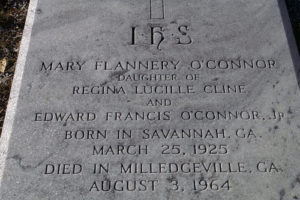 The Final Footprint – O’Connor was interred in Milledgeville, at Memory Hill Cemetery.
The Final Footprint – O’Connor was interred in Milledgeville, at Memory Hill Cemetery.












